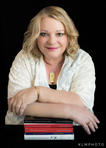William Dyer, landed gentleman
© Christy K. Robinson
William Dyer was the son of a prosperous farmer in Lincolnshire. At age 14,he apprenticed to a master milliner in London,an international trader in fashion and leather accessories for men. His masteremigrated to Boston, Massachusetts, in 1633. William married MaryBarrett, and followed his master and several prosperous friends in 1635. In1637, he was one of many signers on a Remonstrance that was deemed seditious,and along with many Bostonfamilies, was ejected from the colony in early 1638. William was a co-founderof Portsmouth and Newport, Rhode Island.
In this article, you'll see how a farmer's second son became" William Dyre, Gent. ," a landed gentleman.
London, England
1633-35: WilliamDyer leased his former guild-master's home on Greene's Lane near River Thamesin Westminster; leased space in the New Exchangemarket on the Strand, for The Globe, amillinery shop.
Boston, Massachusetts
 Modern Boston, with labels of where Hutchinsons, Winthrops, and Dyers lived in mid-1630s.
Modern Boston, with labels of where Hutchinsons, Winthrops, and Dyers lived in mid-1630s. 1635-36: Ownsland on Shawmut Peninsula (now central Boston) at Summer Street and Cornhill Rd., near Fort Hill;and owns 1/14th (7%) of Boston's town dock.
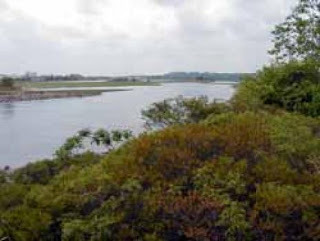 Rumney Marsh, MassachusettsJan. 1637:William Dyer granted 42 acres at Rumney Marsh, Saugus, Massachusetts,"bounded on the North with Mr. Glover, on the East with the Beach, on the Southwith Mr. Cole, and on the West with the highway." Click HERE for more on Rumney Marsh.
Rumney Marsh, MassachusettsJan. 1637:William Dyer granted 42 acres at Rumney Marsh, Saugus, Massachusetts,"bounded on the North with Mr. Glover, on the East with the Beach, on the Southwith Mr. Cole, and on the West with the highway." Click HERE for more on Rumney Marsh. From New England'sProspect, by William Wood, is this description of Rumney Marsh: Rumny Marsh, whichis 4 miles long and 2 miles broad; halfe of it being Marsh ground and halfeupland grasse, without tree or bush: this Marsh is crossed with divers creekes,wherein lye great store of Geese, and Duckes. There be convenient ponds for theplanting of Duckcoyes. Here is likewise belonging to this place divers freshmeddowes, which afford good grasse and foure spacious ponds like little lakes,wherein is store of fresh fish: within a mile of the towne, out of which runnesa curious fresh brooke that is seldome frozen by reason of the warmenesse ofthe water; upon this streame is built a water Milne, and up this river comesSmelts and frost fish much bigger than a Gudgion. For wood there is no want,there being store of good Oakes, Wallnut, Cædar, Aspe, Elme; The ground is verygood, in many places without trees, fit for the plough. In this plantation ismore English tillage, than inall new England, and Virginia besides; which proved aswell as could bee expected, the come being very good especially the Barly, Rye,and Oates.
Winter/spring 1638:William sells land—probably all his land—in Massachusetts Bay area before they move to RI, beingbanished as of the end of March.
DyerIsland in Narragansett Bay
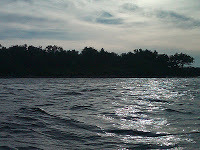 Dyer IslandMarch 24, 1638:As the purchasers of Rhode Island (includingWilliam Dyer) sailed past a small wooded island in Narragansett Bay, Williamasked to be granted that island; it was named Dyer Islandafter him. Some small islands were used to contain goats or hogs; as thisisland has a lagoon, perhaps William used it for bird hunting or fishing. See thedepositions below, made in 1669, when he deeded the island to his second son.
Dyer IslandMarch 24, 1638:As the purchasers of Rhode Island (includingWilliam Dyer) sailed past a small wooded island in Narragansett Bay, Williamasked to be granted that island; it was named Dyer Islandafter him. Some small islands were used to contain goats or hogs; as thisisland has a lagoon, perhaps William used it for bird hunting or fishing. See thedepositions below, made in 1669, when he deeded the island to his second son. 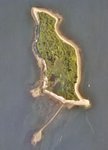 Aerial view, Dyer Island
Aerial view, Dyer IslandSource: NOAADyer Islandis a low-lying 28-acre island situated approximately halfway between AquidneckIsland and the south end of Prudence Island. Despite its smallsize, Dyer Island's ecological value issignificant. It supports one of the last remaining salt marshes withoutmosquito ditches in Rhode Islandand is a nesting area for coastal shorebirds including the locally rare Americanoystercatcher. This uninhabited island also provides foraging habitatfor a variety of shorebirds and was found to support 47 species of seaweed – adiversity second only to Rose Island in the bay. InSeptember 2001, Dyer Island was acquired for preservation andincorporation into the Narragansett Bay National Estuarine ResearchReserve using state and NOAA funds. It will be used in perpetuity forresearch, monitoring,education, and passive recreation. (Source: http://www.eoearth.org/article/Narragansett_Bay_National_Estuarine_Research_Reserve,_Rhode_Island)
Mar 25, 1639: William'sshare of ownership of Bostondock conveyed to merchant (maybe Walter Blackborne, his former master?).
Portsmouth, Rhode Island 1638: There's a copyrighted photo of the lane leading to the Founders Brook where the first settlement
was made on Aquidneck Island. Land granted [Itt To Mr] Wm Dyre At the Cove by the marsh 6 Acres being [10] pole in bredth by 50
in Length y bounded round by the marsh.
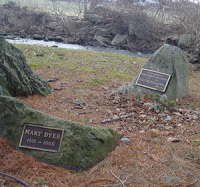 Founders Brook Park memorials to
Founders Brook Park memorials to Mary Dyer and Anne Hutchinson,
Portsmouth, Rhode Island
Source: http://www.newportbristol.com/colony/FoundersBrook.html
Newport, Rhode Island
March 10, 1640, Williamhad 87 acres of land recorded to him at Newport.William Dyre having exhibited his bill under the Treasurer'shand unto the sessions held on the 10th of March, 1640, wherein appears fullsatisfaction to be given for seventy-five acres of land, lying within theprecincts of such bounds, as by the committee, by order appointed, did bound itwithal, viz.: To begin at the river's mouth, over against Coaster's Harbour,and so by the sea, to run up to a marked stake, at Mr. Coddington's corner, andso down, upon an easterly line to a marked tree over against the Great Swamp,and so two rods within the swamp, at the two deepest corners of the clear land,the one at the southeast corner, and the other upon a straight line in thenortheast, marked by stakes, and so down to a marked tree by the river side;the river being his bounds to the mouth thereof. with a home lot and a parcelof meadow and upland lying between Mr. Jeremy Clarke's meadow, and Mr.Jeoffrey's at the north end of the harbour, and north upon the highway, withten acres allowed by the town order for his travelling about the island, lyingwithin the former bounds, which is his proportion. "This, therefore, doth evidence and testify, that allthose parcels of land before specified, amounting to the number of eighty-sevenacres, more or less, is fully impropriated to said William Dyre and his heirsfor ever."
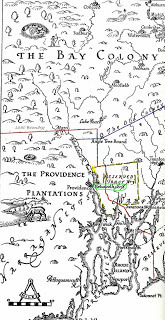 1650 map. Perhaps William Dyer
1650 map. Perhaps William Dyer was one of the surveyors who
reported to the cartographer.
1644: William buys30 acres adjacent to Dyer farm. Sells 10 acre neck of land to George Gardner. William recorded this about himself: "WmDyers farm [June or January] 20th 1644: Memorandum that the farm of WilliamDyre of Newport in the Isle of Rhodes consisting of all well the lands that wasgranted unto him by the said town as also of several purchases that he, saidWilliam, made of divers lands that adjoined hereunto amounteth to the number ofone hundred forty acres more or less."
1661: Land in Narragansett, called Misquamokuck (nowWesterly), was taken by William Dyer, Sr., Samuel Dyer, and MahershalalhashbazDyrer, and articles of agreement between an Indian captain and others weresigned by them. William Dyer was appointed to transcribe the deeds,testimonies, ratifications, etc. At a general meeting, February 17th, 1661-2,William Dyer was chosen surveyor of Misquamokuck. At the court held at Aquidneck,near Wickford, May 20th, 1671, the persons inhabiting here being called to givetheir encasement and desiring; to know whether or no the court, on behalf ofthe colony, do lay any claim to their possessions which they now inhabit, whichpersons were Mr. Samuel Dyer and others. To which demand this present court doreturn unanimously this answer: That on behalf of the colony this court do notlay any claims to their possessions which they now inhabit. (Source: http://www.archive.org/stream/somerecordsofdye00dyer/somerecordsofdye00dyer_djvu.txt)
1668-69: WilliamDyer surveys New Hampshire and Maine for geology andnatural resources before writing proposal to King Charles II. The proposal wasprinted in Londonin 1670.
1669: WilliamDyer may have become ill and put his estate in order, in the event he wouldn'trecover (he lived another seven years). Depositions were made that Williamowned Dyer Island. Dyer Island, off Portsmouth:(Source: http://www.archive.org/stream/documentaryhisto02chap/documentaryhisto02chap_djvu.txt)
Theaffidavits in regard to this gift follow: "Towhome these shall Concern I Testefy that the little Islandlying in the bay on the North Side of the wading River was given Mr Dyre by thePurchassers. 31 October 1650 Jno. Sanford.
IAttest that the above written Premisses were by my fathers Order and Comand byme written my father then being very sick and ill witness my hand the 4th ofOctober 1669 John Sanford.
I doafirm also that as wee past along by the afore-said Island the Purchassers gavethe said Island to Mr William Dyre. Nov. 1,1650 John Porter.
Thisis to Testefy that I Roger Williams being acquainted (by the good Providence ofGod) with the first Conception Birth and growth of Rhode Island (aliasAquednick) doe Asert and affirme as in the holy Presence of God, that bythe Consent of the first Purchassers ofRhode Island (Dead and liveing) the litle Island Comonly Called Dyres Islandwas from the first and allways (sometimes in Meriment) but always in Earnestgranted to be not only in Name but also in truth and reality the Proper Rightand Inheritance of Mr William Dyre of Newport On Rhode Island. Roger WilliamsAssista:" (R. I. L. E. I, 267., Po. R. 376.)
"CaptnRandall Houldon of Warwick in the Province of Rhode Islandiff Providence Plantation aged 57 years or thereabouts being Ingaged accordingto law Testefieth as followith That the Purchassers gave that litle Island Called Dyres Island to Mr William Dyresenior that was then one of us and further saith not. Taken the 24th day ofJune 1669."
"IDoe affirm that wee the Purchassers of Rhode Island (my selfe being the chief)William Dyre desireing a spot of land of us as we passed by it, after we hadPurchassed the said Island, did grant him Our Right in the said Island andnamed it Dyres Island. Witness my hand. October 18th 1669 William Coddington."
"IRichard Carder being a Purchassere doe own the above said writeinge: November:7th 1669 by me Richard Carder"
"WilliamCooley aged 66 years or thereabouts being Ingaged Testefieth that in the firstyear of the setling of this Plantation of Newport he being Master of a boat andJeffery Champlin and Richard Series being of his company, and stoping at theIsland Called Dyres Island mr William Dyre in Presence of them took posessionof the said Dyres Island and further saith not. Taken before me this 6th of December1669. John Green Assistant" (R. I. L. E. I, 267., Po.R. 346.)
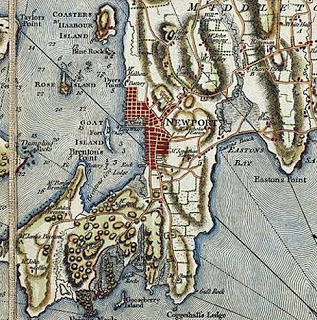 1777 map of Newport, RI. The Dyer farm probably extended
1777 map of Newport, RI. The Dyer farm probably extended from Dyer's Point (now the Battery Park), north to the
land opposite Coaster's Island. 1669: WilliamDyer sold 12 acres of land to Peleg Sandford.
1670: Williamdeeds northern part of Newport Dyer farm to son Henry in Henry's 21styear. William directs properties to sons and money to daughters. July 25: Samueland Henry Dyer bind themselves to their father William Dyer to pay to theirsister Mary Dyer Ward, eldest daughter of William, £100 within three yearsafter the death of their father and to Elizabeth Dyer, second daughter ofWilliam by his second wife Katherine, the sum of £40 when eighteen years of age[1679].
William Dyre of Newport, ,Gent: granted to my sonn Henry Dyre into that part of my farme lyinge at thenortherly and thereof: to witt, from the Stone Ditch. as alsoe from the treewhere my sonn Mahers Tobacco house stood, from the Cave to and by that treeupon an Equidistante line from the said Stone Ditch downe unto and through theswamp unto mr. Coddingtons line by the brooke. (the fence is equally devided)percell of Land so bounded with a free Egress ingress and regress to andthrough the land of my sonn Samuels but in case my sonn Henry should have Issueonly Femailes then my sonn Samuell after the death of the said Henry shall Giveone hundred and fifty pounds starllinge the eldest to have a double portion therest an equall dividend of the Residue, but if only one all to her &cbesides the Valluation of the houssinge thereon built the Land to return to Samuell 7th day of July 1670. William Dyre. Wit The X marke off.
Robert Spinke
John Furnell
August 5, 1670: "WilliamDyre of Newport, gent.," deeded to "my sonWilliam Dyre...my island called Dyre's Island lying and being situated in Narrogansett Bayupon the northern side of Rhode Island overagainst Prudence Island."
1676: WilliamDyer dies at age 67, and farm is inherited by his sons; his two daughtersreceived financial bequests by 1679, as did his second wife Katherine. Sons: · SamuelDyer b. 1635 d. 1678, resided Kingston, RI with wife Anne Hutchinson Dyerand seven children, on lands granted by her father, Edward Hutchinson. Odd thatSamuel, as eldest son, wasn't deeded the Dyer properties at the same time ashis younger brothers. Yet, in 1687, his son Samuel sold his portion of the Dyerfarm to his uncle Charles Dyer. Probably Samuel Sr. automatically inheritedwhatever land his father hadn't deeded to other sons, when William Sr. died.Samuel Sr. died only a year or two after his father. · WilliamDyer Jr. b. 1640 d. 1688 (Customs official and Mayor of New York), resided Delaware. Williambequeaths Dyer Islandand large estates in Delaware and Pennsylvania to his sonWilliam Dyer and five other children.· MaherDyer, b. 1643 d. before 1670, resided Portsmouthand Newport. Hewas married for about five years, but his wife had no living children. · HenryDyer, b. 1647 d. 1689/90, resided Newport.Had two children.· CharlesDyer, b. 1650 d. 1709, resided Newportand Little Compton, RI. Charles Dyer moved from his farm in Little Compton to Newport to raise hischildren. Charles' will leaves the Newportfarm to his son Samuel and the house and its contents to his second wife Martha(who raised his five children after his first wife Mary died); after her deathit reverted to Samuel or his heirs. In addition, Charles said, "My earnest willand desire is (that) piece of ground that is now called the Burying Ground,shall be continued for the same use unto all my after generations that shallsee cause to make use of it, and I order that it shall be well kept fenced inby my son Samuel Dyre and his heirs forever."
1679: At the May12, 1679 court, "upon indictment by the General Solicitor against KatherineDyre of Newportfor misbehavior [apparently she sued Samuel Dyer's widow, Anne HutchinsonDyer], she being in court called, appeared: pleads not guilty and refers fortrial to God & the country. The Court upon serious consideration of thematter see cause to quash the bill." Katherine then sued her stepson CharlesDyer in 1682, in a £30 complaint of trespass, in which the jury found forCharles.
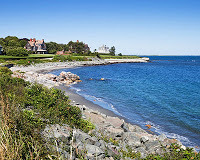
1687: Charles Dyre of Newport, Husbandman, boughtof [oldest brother Samuel's son] Samuel Dyre of Boston, carpenter, land in Newport,Bounded on the East, partly by certain lands in possession Mr. Francis Brinley& Left Collo of Peleg Sanford on the South, by land of Late Mr. NicholasEaston and Mr. Johnson the West, by the sea on North by land of HenryDyre.—with house, orchards, Gardens, meadows, woods, swamp--layed out unto mistressKatharine Dyre [his stepmother] by town of Newport 1681 as her Right of Dower.5 Oct1687. Witt. Weat Clarke, Robert Little, Daniel Vernon. (Source: Rhode Island Land Evidence 1648-1696 -Abstracts Vol 1page 206)
Click HERE for a view of what used to be the Dyer property of Newport, Rhode Island.
Published on November 28, 2011 05:00
No comments have been added yet.

